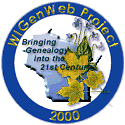 |
|

Home What's New in WIGenWeb Project Getting Started Wisconsin Resources Maps & Gazetteers Immigration & Naturalization Wisconsin Archives Volunteer Pages |
Small groups of French fur traders came to the Green Bay and Prairie du Chien areas in the 1700s. They were followed by lead miners from the Southern states who settled near the Galena diggings on the Illinois border in the 1820s. Substantial immigration from the northeastern states began in the 1830s. Later, American-born settlers were usually from New York, Ohio, Pennsylvania, and Vermont. Between 1840 and 1860, hundreds of thousands of immigrants came from Europe. Most of them came by way of the Erie Canal and the Great Lakes to the port of Milwaukee, or they came up the Mississippi and Wisconsin Rivers and then by the railroads, which crossed the area soon after Wisconsin statehood. The most numerous of the foreign-born immigrants were from Germany. They came from the Catholic provinces of southern Germany and from Protestant eastern Germany. Before the Civil War, the Irish were the second largest immigrant group in Wisconsin. There was also considerable emigration from England, Scotland, Wales, and British North America. Many Norwegians came to Wisconsin before the Civil War and by 1900 had become the second-largest foreign-born group in the state. They were joined by settlers from southern and eastern Europe, especially Poles and Czechs, and by smaller groups of Russians, Yugoslavs, Italians, and Greeks. At the beginning of World War I in 1914, the majority of Wisconsin residents were of German origin or descent, but this had declined to 40 percent by 1930. RecordsPassenger lists are not available for Milwaukee (the main port), or any of the other Wisconsin ports. Most immigrants from overseas landed at east-coast ports, primarily New York City, before heading toward Wisconsin. If �Milwaukee� is noted as the port of entry, it is likely that the immigrant actually arrived at the port of Quebec, Canada, and then came through the St. Lawrence/Great Lakes to enter the United States at Wisconsin. This was an important route particularly for the Norwegian immigrants. The �St. Albans Passenger Arrival Records,� is a collection of millions of cards that provide information about people who crossed the border between Canada and the United states. It includes passengers arriving by train through substations or ports along the borders from Washington to Maine. Each card typically provides name, age, exact place of birth, last residence, occupation, name and address of relative in former country, name and address of relative in the destination city, whether the person�s first visit to the U.S., date and vessel of seaport arrival, date and place of border crossing, and physical description. The St. Albans indexes include the entire United States-Canada border from 1895 to 1915. The 1915-to-1924 indexes cover the border east of Buffalo, New York, only. The Family History Library and the National Archives have passenger lists or indexes for American ports for the years 1800�1921 for Philadelphia, 1820�1943 for Boston and New York, and 1865�1900 for Canadian ports. Indexes are being published for many ethnic groups, such as the Czechs (1846�), Italians (1880�), Germans (1850�), Greeks (1885�), and Russians (1875�).
Naturalization records have been filed primarily in municipal, county, circuit, supreme, and U.S. district courts. Some of the older evidences of citizenship are found in the minutes of these courts and not in separate books. The records of approximately two-thirds of the counties are on microfilm at the area research centers. The Milwaukee circuit and municipal court records of 1836 to 1941 are at the Milwaukee County Historical Society, 910 North 3rd Street, Milwaukee, WI 53203. For naturalization records after September 1906, contact the National Archives�Great Lakes Region or the local office of the Immigration and Naturalization Service. The archives branch has records of the U.S. District Court from 1866 to 1921 and an extensive index to other federal records. |
State Coordinator: Marcia Ann Kuehl
Copyright © 1999 - Kelly Mullins and the WIGenWeb Project
WIGenWeb Project logo created by Debbie Barrett
This page is a collaborative effort. If you have any ideas or questions,
Assistant State Coordinator:
Rebecca Maloney
Special thanks to Vicki Wilson, Kelly Mullins and Tina Vickery Wisconsin's previous State Coordinator.
please contact the State Coordinator, Marcia Ann Kuehl
.